Carabobo FC won their first Venezuelan trophy in the first semester of 2024.
They won the Apertura under Diego Merino’s coaching, and now they are playing the Clausura.
Founded in 1997, “El Granate” are one of the teams that will play in the Grand Final for the title of Venezuelan Champion this year.
Merino, former Rayo Vallecano youth categories coach, took the brave step of leaving Spain and accepted the challenge of coaching in Venezuelan football.
In his first experience as head coach in the first division, he became the first Spanish coach to win the Liga FUTVE.
At Total Football Analysis, we had the privilege of interviewing Diego Merino during his second tournament in Venezuelan football.
In this exclusive interview, we will provide an in-depth analysis of Merino’s Carabobo after speaking with him to understand his philosophy, methodology, and tactics.
Who Is Diego Merino?
The 36-year-old coach started his career when he was 20.
After a knee injury as a player, he became a coach in youth football.
When he was 23, he arrived in the Rayo Vallecano youth categories.
By 25, he had won two youth tournaments.
After this remarkable experience, he started his journey in senior football.
He passed through Extremadura, Astorga, Moralo CP, Mérida AD, CD Toledo, and CD Coria — senior teams across different divisions of Spain.
Years ago, after a personal meeting with Salvatore Simeone, the present Sporting Director at Carabobo, Diego Merino never forgot the idea of being a coach in Venezuelan football.
Finally, he signed with the team in January 2024.
Since then, the team has built a solid identity.
How Do Carabobo Play Under Diego Merino Tactics?
In football, like a director in cinema, a game model is the coach’s vision, personality, and intention.
After various months of work, we can analyse Merino’s game model with Carabobo.
However, there is nothing better than hearing his vision.
“I like the organisation; sometimes, people think that ‘organisation’ is a defensive topic, but I say this generally.
In each phase of the game, I want a team with clear intentions and structure.”
Carabobo occupy the pitch in a 4-3-3 with some modern elements unusual to see in Liga FUTVE.
Merino’s side are a physical team, vertical when they get the ball, deploying deep wingers on both sides, technical players to execute a clean passing circuit in different angles and giving importance to winning duels.
Full-backs are occasionally inverted in the build-up — Miguel Pernía usually performs this role.
The image below shows the configuration of the defensive line in the initial phases.
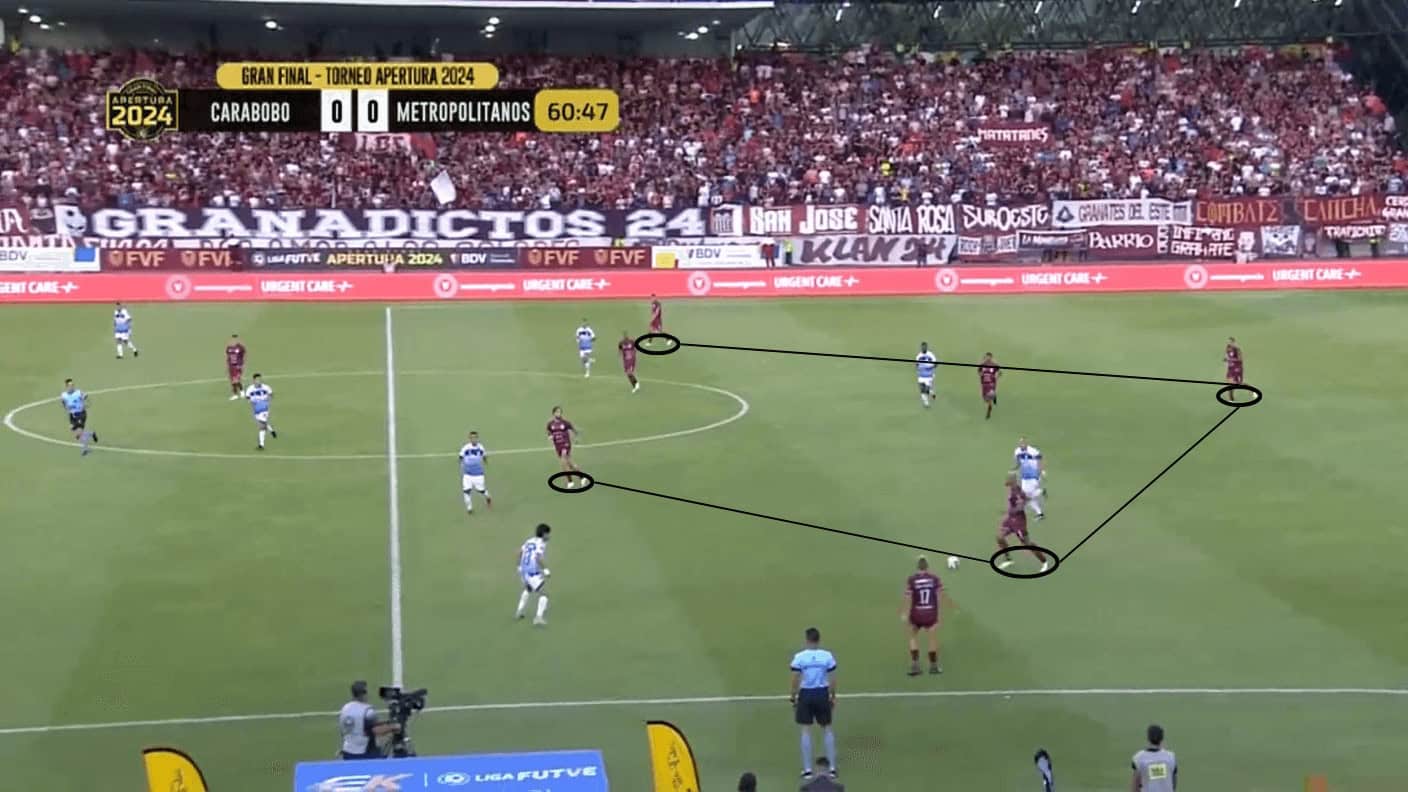
Somebody is always positioned at maximum width to stretch the pitch.
In general, this could be called a positional proposal.
Their game features natural rotations with designated spaces and positional advantages.
“The team has designated a number of spaces, and the player can participate in different zones, always under rigour, order, and natural rotations, which keeps us safe after losing the ball.
Like this, we occupy the spaces that we think are important to progress within the game.
We are working so much, giving it much continuity.
Every day we work on it, the level of coordination becomes faster and less detectable, and on matchday, we can create advantages.
This is not easy at all — this is hard because some players are not in their comfort zone, and they are influencing in determined spaces, which, at the beginning, was complex — but I’m really satisfied with the development of the team.”
Merino is an observer, constantly applying little improvements to his team.
“I take a percentage of my time to keep learning from as many sources as possible; I’ve never seen the way we are attacking, not even the way we were attacking in the Apertura or in my other teams.
Every day, I try to be better and grow — this is what I most like in the profession.
The technical-tactical work, to innovate and create — the possibilities are infinite.
Probably, if one day I wake up and I’m not feeling that fire, I will not be a coach anymore; it is what keeps me alive.”
About these improvements —or adjustments—throughout the year, Carabobo’s pivot is an example of one.
When Carabobo restart the play or when they are in the build-up, Harrison Contreras usually moves around to get the ball in good angles to send long balls or progress.
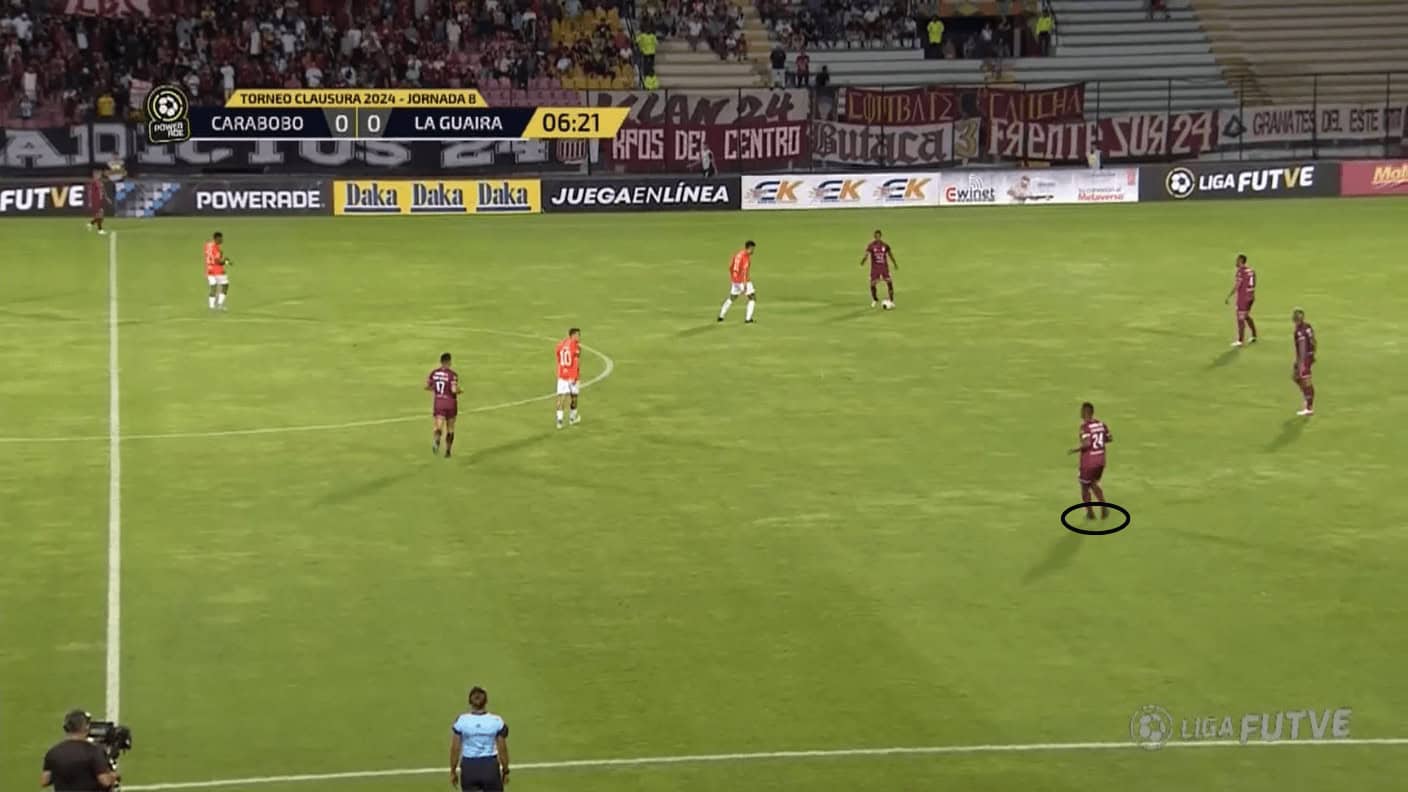
From the beginning of the year until the end of the Apertura, he was always positioned in central channels.
Harrison Contreras Touch Map
Look at his touch map in two different matches and times — against Deportivo La Guaira, a few days ago, and Metropolitanos in the Apertura final match.

We asked Merino about this.
“Harrison, in the Apertura, was neutralised in two matches by two strikers’ pressing shapes — with two players, the rival was defending three of us, our centre-backs and our central midfielder, and he is a crucial player for us.
What are we trying to do? Well, Harrison now has two intervention spaces, and the rival must adjust to two different procedures while we find Harrison free or space for any other player.
Then, one of the parts we have been working on is the way to attack the opposition’s defensive line.
We created much danger by passing in behind, attacking the half-spaces, and overloading the far post.
So, what we are trying to do now is to attack in behind deeper.
After analysing that the prominent defence across the tournament is man-to-man, less zonal, we can exploit the offsides.”
In that sense, offensively, as Merino likes the order, he is betting mainly for qualitative superiorities this part of the year.
“There are numerical, positional, and qualitative superiorities, and sometimes we need the quality to win matches.”
Defensive Versatility, Less Positional Attack
What makes Carabobo special in Venezuelan football is their versatility.
They are capable of defending in a low block or press higher and being accurate in both.
“The team that I want is balanced.
After the match against Deportivo La Guaira, I told my players: ‘when we understand that we can generate a goal opportunity with a pass, with five passes, or with 15, we are a team with more resources.’
What is undoubted is the balance, but he is adaptable in the attacking phase.
“Offensively, it varies on the types of players you have and the league where you are the match…
My team can be an associative team, can attract and look for attacking in behind, load the box, or attack deeper in the last step.
But always a balanced team.”
Nevertheless, the main focus now on improving is the defensive phase.
“I don’t like only speaking about it.
Today, it seems like football is all about attack, and telling you things about defensive concepts is worse, but to be competitive, you must give the same importance to everything, and that’s what we try.
At this point, I’d love to get back the solidity — I think we’ve conceded more goals than we should have done.”
In comparison with the first part of the year, Carabobo are a more reactive team.
The volume of counter-pressing was reduced, as the image below shows.
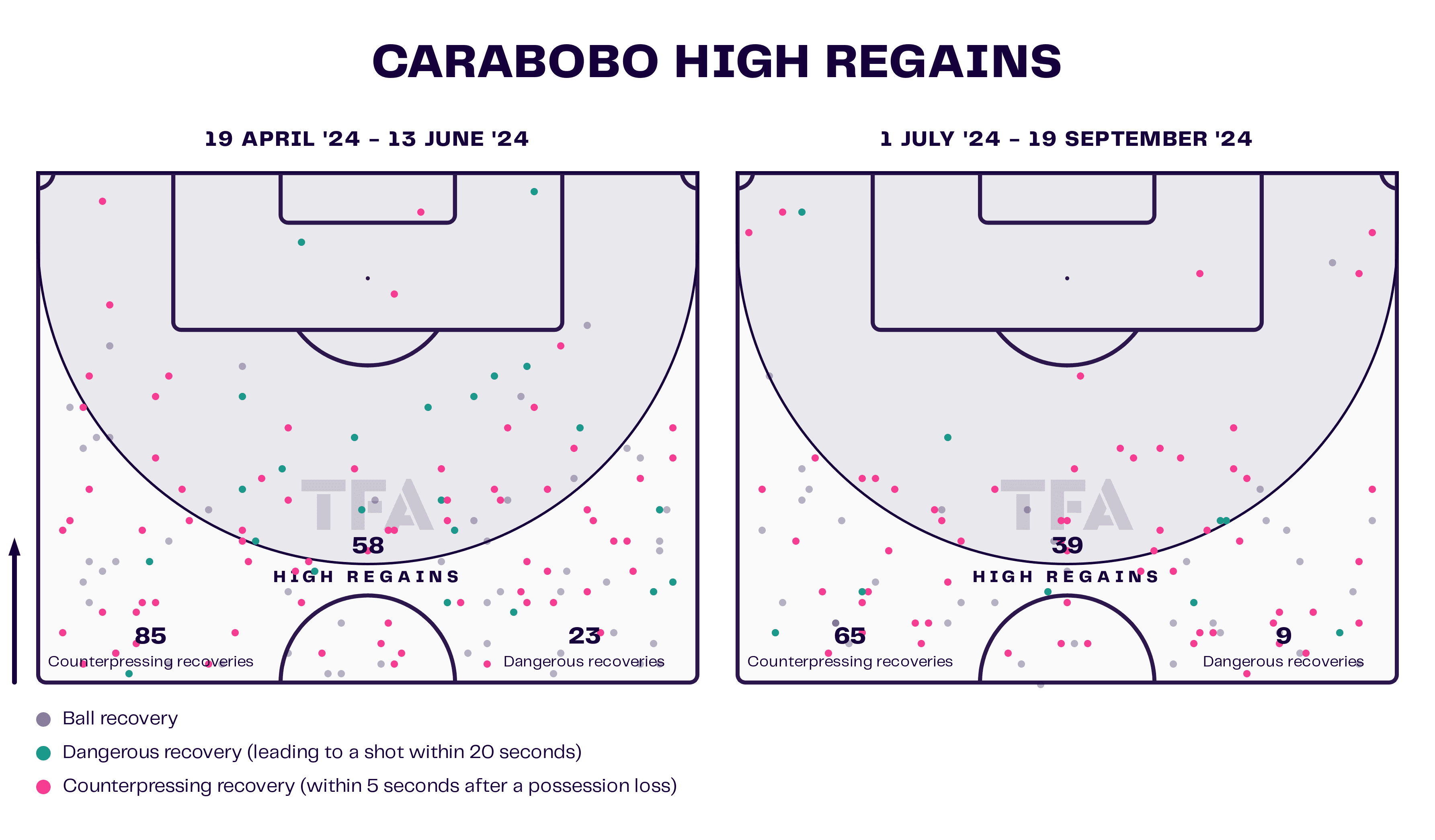
In the last eight Apertura matches, they accumulated 19 regains, more than in their first eight Clausura matches.
So, Carabobo are making changes in their defensive structure, in part because Merino already realised some tactical conditions in South American football.
“[on why is this happening] Firstly, it has a direct correlation with stamina.
South American football is about transitions, running, and velocity… less accurate in positional attacks.
So if you defend organised, without being in a hurry to steal the ball, you are capable of defending well.
Not defending well by only protecting your goal, but winning possession through interceptions or second balls.
I think provoking excessive jumps in high pressing becomes the match in a constant get-go — then some shifts can be bad, and at any moment, your block can be separated.
There, the rivals create so much danger.
Also, it depends on the player profiles.
For example, the first pressure line has many distinct details depending on which players are starting.
It is not the same facing a team that tries to skip lines or another one that has resources inside to progress by central channels.
I think now every match is following the same line defensively.
However, each rival, each moment, the goals that change matches… You have a script, but then everything could happen.
In faster football, having a good positional defence —organised, narrow, and reading well the pressure jumps—gives you an advantage.”
The goal opportunities are similar, even making changes in the position of the recoveries and adjustments in some roles within the pitch.
Look at their shots map in comparison between the last eight Apertura matches and the first eight Clausura matches.
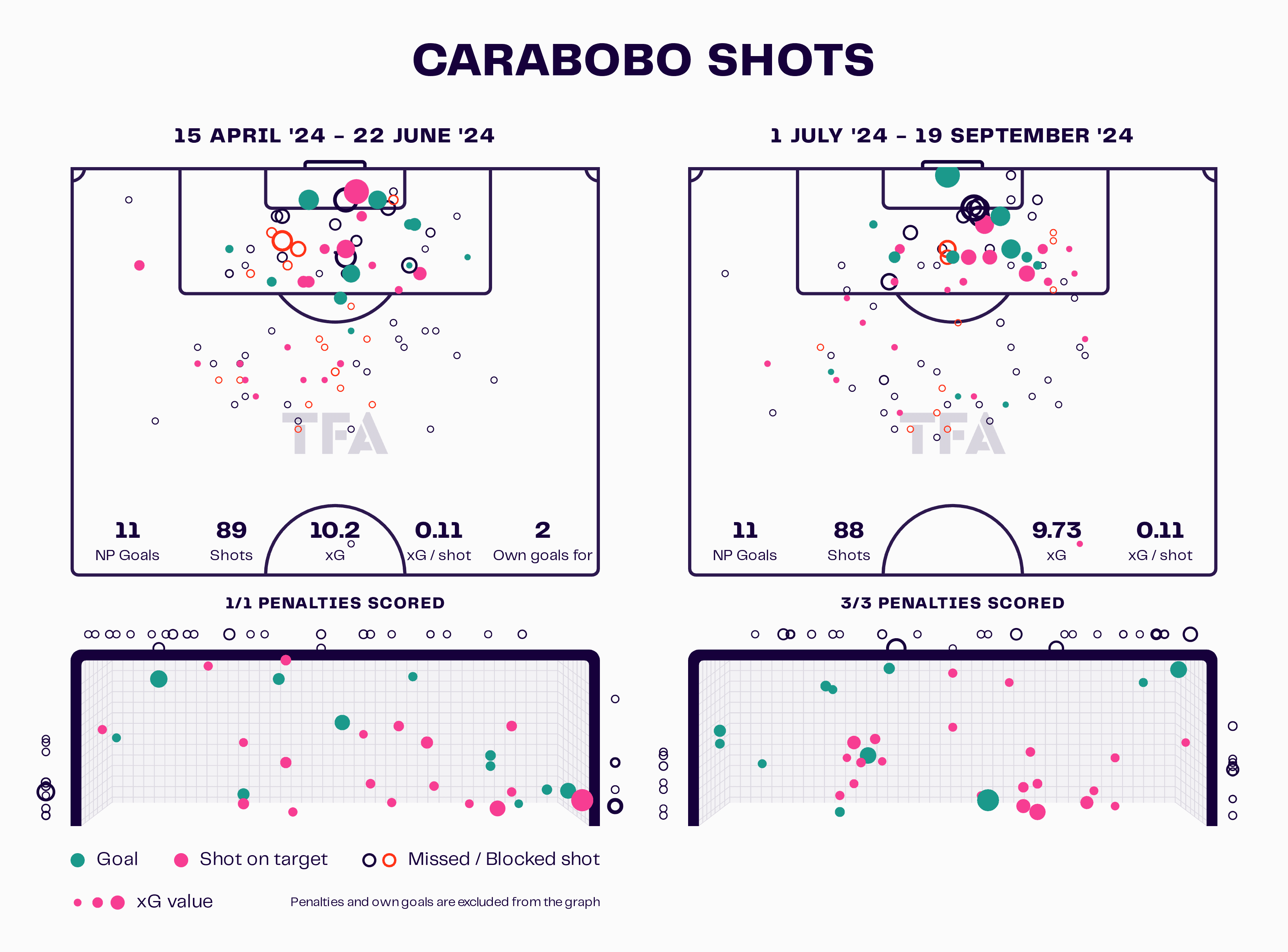
Determining Factors In Venezuelan Football: The Back Three
Diego Merino says he has a script; his team has a regular structure.
However, something that has required adjustments is when the opposition plays with a back three.
When the rival is defending like that, Merino has made a few changes in his structure.
Let’s know his vision on this topic and how he faced these types of shapes.
“We have our own procedures — if a team changes weekly, they cannot build an identity.
Actually, against odd-defensive lines like Monagas, Metropolitanos, and La Guaira, we attacked each one differently.
Against one of them, we looked for an extra height in one of the wide areas.
In another, we overloaded the centre and designated duels in wide areas; in another one, we used our basic structure.
Inside all of this, there are many small details — micro-concepts that we applied.
In pressing, we have adjusted in different directions too.
It is complex because these types of teams occupy the five lanes and make the pitch wide.
But after they lose the ball, they are vulnerable, mainly because of the height of the wing-backs.
And we have exploited some transitions that they’ve allowed us.”
The Main Defensive Trouble: Set-Piece Actions
It is not a secret that the main weakness of Carabobo’s defensive system is at set-pieces.
Diego Merino started with a zonal marking idea, but the performances made him switch to a mixed-marking configuration.
The strategy started being more zonal, as the below image shows.
Now, it is mixed, focused more on man-to-man marking.
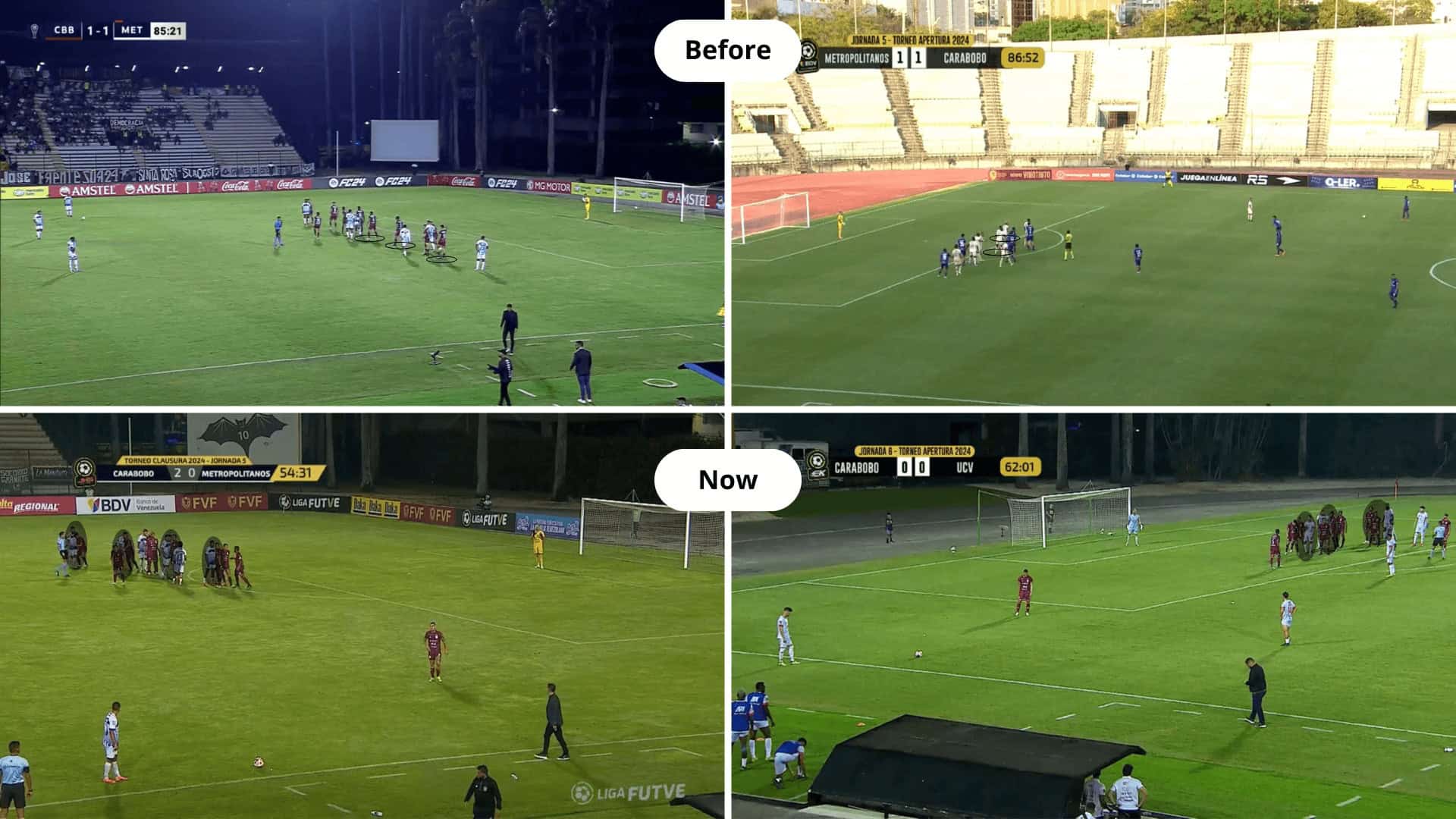
“I have always preferred a zonal marking when defending set pieces.
Due to performance, now we are defending mixed, but I think it is worse because we are very aligned, and if there are some mismatches when dropping, we don’t take advantage of the offside.
Each type of configuration has pros and cons, it is true, but I feel better with the zonal marking.
Now we act like this because of the performances, and at Liga FUTVE, there are many goals by set-pieces, so we have to take care of ourselves”, Merino said.
And this is part of adapting.
The naturality of the players in Venezuela is prominent man-to-man marking at defending set-pieces.
Once a player drops earlier while following an attacker, then the offside is not defending the situation.
The Mental Fight
No matter what, Carabobo only need a win to be the Venezuelan champion: the Grand Final.
And this is a double-edged sword.
The competitiveness is not the same in a league format when you know that you’ve won and that you are qualified for the final.
Maybe that’s why Carabobo have conceded more goals in Clausura than in the Apertura.
“I think we cannot ignore the moment.
I mean, we don’t fall here, something happened before.
And when we are coming from being the champion, we fight mentally against a circumstance that is already there — everyone is fighting for something that we’ve already got.
‘Yeah but you must fight for it’ — sure, but we already got it.
So the level of need, urgency, and attention is measurable.
It is not a coincidence, because many Latin American teams have passed through something like this.
For me, in certain moments, we have lost our focus on defensive actions that have made us less solid defensively — a retreat/a total-block defence.
And we have to keep working and developing.”
Conclusion
Diego Merino has given Venezuela a fantastic style of play through a demanding methodology.
The Apertura was an important goal.
Now, Merino is one step away from becoming the first Spanish champion in Venezuela.
Being 36 and onto his first experience within a first division, he is a coach who lives day by day, as he told us when we asked about Copa Libertadores.
“I don’t think in playing Libertadores; I live day by day.
Still, I see the Grand Final as being really far from today — Copa Libertadores sounds really, really far.
We’re clear we need to do our best and keep working week by week.
It would be a dream to win the first total trophy in this club.
There is nothing better for me than to make it real.
As a coach, I can tell you that Copa Libertadores should be beautiful.”
In 2025, we are going to see Carabobo competing internationally, which is going to be another great achievement in Merino’s career.

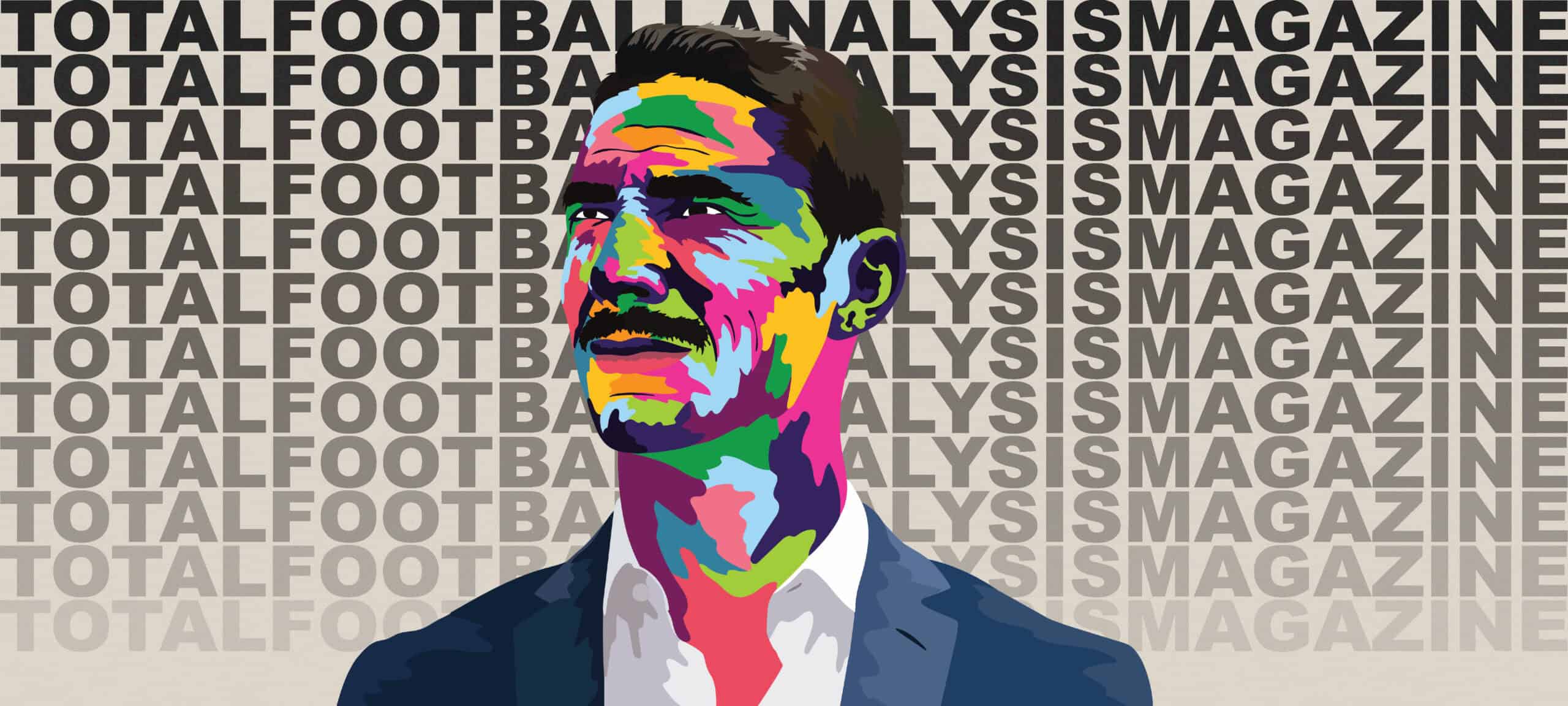




Comments